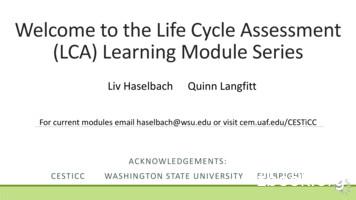Life Cycle Assessment Of Computers
!July!17,!2013!Life%Cycle%Assessment%Key Findings ) Manufacturing)and)Assembly)Product)Use) It is much more beneficial to use computersto their end-of-life due to the environmentalimpacts and energy required during rawmaterial extraction, processing, andmanufacturing of new computers.Reusing and recycling computers can lessenthe environmental impacts of computers.Reuse means reselling or donating in orderto ensure a 2nd lifespan of computers isrealized before final disposal.Recycling computers at the end-of-life iscrucial to salvage materials necessary for theproduction of new oduction)While the efficiency of computers is increasing,there is often times pressure on consumers to replacetheir outdated devices with new, more efficientmodels. However, disposing of devices before theirend-life often causes unforeseen and unintentionalenvironmental impacts that are explicated below.Therefore, the real question involves balancingdifficult tradeoffs: energy inefficiency leading toincreased emissions or life cycle costs whichinvolves the extraction of raw materials, processing,manufacturing, use, and disposal processes.Replace or Use?It is much better to use computers to their end of lifedue to the substantial environmental impacts causedduring the raw material extraction, processing, andmanufacturing process. For example, in generalreselling or upgrading just 10% of end-of-lifecomputers reduces life cycle energy significantlycompared to recycling (Table 1). In fact, resellingand upgrading can be 20 and 12 times more efficientat reducing life cycle energy compared to recycling(Table 2) (Williams 2003). The production ofcomputers contains a greater energy demand thanactual use, meaning there should be a greateremphasis on proper management and life spans ofcomputers. Even if computers are recycled, theretrieval of raw materials does not undo theenvironmental burden associated with processingand manufacturing. Therefore, it is more beneficialto use computers to their end-of-life.
21!July!17,!2013!!Table 1: Results from reselling, upgrading, or recycling 10% of end-of-life computers (Williams 2003)End of LifeLife Cycle Energy able 2: Energy Values for Desktop Computers (Williams 2003)Life Cycle StageProductionUse (2 year 1st lifespan)Use (3 year 1st lifespan)2nd lifespanUpgrade (energy for parts)RecycleMore specifically, in order to produce a desktopcomputer with a 17-inch display screen, it takesabout 1800 kilowatt-hours and 260 kilograms offossil fuels. The ratio of fossil fuel use and theweight of the computers is 11 to one, representing avery energy intensive process. This large energy usecoupled with a high turnover rate results insubstantial energy consumption. Additionally,computers are unique to other appliances in thattheir energy use is caused primarily from production(81%) rather than operation (19%) (Williams 2004).When comparing desktop computers with laptops,laptops show a significant decrease in power usage.A study conducted by the University ofPennsylvania showed that nine out of their tendesktop computers showed a higher watt usageunder moderate use compared to their eight laptopcomputers (Table 3 and 5) (Penn Computing 2013).Rather than using desktops, perhaps businessesshould require laptops to be used in the workplace inorder to save energy. Tables 4 and 6 provide costsassociated with each model; however, due to therapid turnover rate, many of these models have beendiscontinued and cannot be purchased by thesupplier/manufacturer. )2!!Energy Value1556 kilowatt hours253 kilowatt hours378 kilowatt hours1-2 years486 kilowatt hours-77 kilowatt hours(theoretical limit)-378 kilowatt hours)ConclusionIn the office, computers have the second highestenergy consumpt
Dell XPS 12 12.5-inch 1099.99 Dell Latitude E4200 12-inch Discontinued Dell Latitude XT2 XFR 12-inch Discontinued Dell Inspiron Mini 10 10-inch Discontinued Lenovo ThinkPad X100e 11.6-inch Discontinued Lenovo ThinkPad T400s 14-inch Discontinued Lenovo ThinkPad T410s 14-i
2.1 Life cycle techniques in life cycle sustainability assessment 5 2.2 (Environmental) life cycle assessment 6 2.3 Life cycle costing 14 2.4 Social life cycle assessment 22 3 Life Cycle Sustainability Assessment in Practice 34 3.1 Conducting a step-by-step life cycle sustainability assessment 34 3.2 Additional LCSA issues 41 4 A Way Forward 46
Life Cycle Impact Assessment (LCIA) "Phase of life cycle assessment aimed at understanding and evaluating the magnitude and significance of the potential environmental impacts for a product system throughout the life cycle of the product" (ISO 14040:2006, section 3.4) Life Cycle Interpretation "Phase of life cycle assessment in which the .
life cycles. Table of Contents Apple Chain Apple Story Chicken Life Cycle Cotton Life Cycle Life Cycle of a Pea Pumpkin Life Cycle Tomato Life Cycle Totally Tomatoes Watermelon Life Cycle . The Apple Chain . Standards of Learning . Science: K.7, K.9, 2.4, 3.4, 3.8, 4.4 .
Life Cycle Impact Assessment—phase of life cycle assessment aimed at understanding and evaluating the magnitude and significance of the potential environmental impacts for a product system throughout the life cycle of the product. Life Cycle Interpretation—phase of life cycle assessment in which the findings of either the
4.UNEP/SETAC (2011). Global Guidance Principles for Life Cycle Assessment Databases. UNEP/SETAC Life-Cycle Initiative. ISBN: 978-92-807-3021-. 5.UNEP (2003). Evaluation of environmental impacts in Life Cycle Assessment, Division of Technology, Industry and Economics (DTIE), Production and Consumption Unit, Paris. 6.ISO 14040 (2006).
3.1 life cycle 3.2 life cycle assessment 3.3 life cycle inventory analysis 3.4 life cycle impact assessment 3.5 life cycle interpretation 3.6 comparative assertion 3.7 transparency 3.8 environmental aspect 3.9 product 3.10 co-product 3.11 process 3.12 elementary flow 3.13 energy flow 3.14 feedstock energy 3.15 raw material LCA MODULE A1 18
2.0 Life Cycle Assessment (LCA) 5 2.1 Life Cycle Inventory (LCI) 7 2.2 Life Cycle Impact Assessment (LCIA) 11 2.3 Framework 13 2.4 System Boundaries 16 2.5 Limitation and Problems 19 3.0 Life Cycle Cost Assessment (LCCA) 20 3.1 Life Cycle Cost (LCC) 20 3.2 Levelized Cost of Energy (LCOE) 22 3.3 Financial Supplementary Measures 23
BCA-S101T Computer Fundamental & Office Automation 3 0 0 3 UNIT-I Introduction to Computers Introduction, Characteristics of Computers, Block diagram of computer. Types of computers and features, Mini Computers, Micro Computers, Mainframe Computers, Super Computers. Types of Prog






















